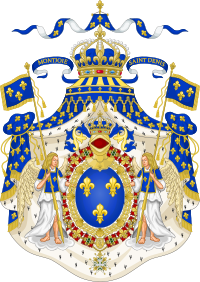National Emblem of France
| National Emblem of France | |
|---|---|
 |
|
| Details | |
| Armiger | The French Republic |
| Adopted | 1912 (1953) |
| Escutcheon | RF, standing for République française |
| Other elements | Fasces, laurel branch, oak branch |
The current emblem of France has been a symbol of France since 1953, although it does not have any legal status as an official coat of arms. It appears on the cover of French passports and was originally adopted by the French Foreign Ministry as a symbol for use by diplomatic and consular missions in 1912 using a design drawn up by the sculptor Jules-Clément Chaplain.
In 1953, France received a request from the United Nations for a copy of the national coat of arms to be displayed alongside the coats of arms of other member states in its assembly chamber. An interministerial commission requested Robert Louis (1902–1965), heraldic artist, to produce a version of the Chaplain design. This did not, however, constitute an adoption of an official coat of arms by the Republic.
Technically speaking, it is an emblem rather than a coat of arms, since it does not respect heraldic rules—heraldry being seen as an aristocratic art, and therefore associated with the Ancien Régime. The emblem consists of:
- A wide shield with, on the one end a lion-head and on the other an eagle-head, bearing a monogram "RF" standing for République Française (French Republic).
- A laurel branch symbolises victory of the Republic.
- An oak branch symbolises perennity or wisdom.
- The fasces, a symbol associated with justice (the bundle of rods and an axe, carried by Roman lictors).
In September 1999, the French government adopted a unique official identifier for its communication, incorporating the Republic's motto, the colours of the flag, and Marianne, the Republic's personification.[1]
 The logo of the French government |
 The symbol is used on plaques marking French consulates |
History
| Coat of Arms of France | Description | Dates Used |
|---|---|---|
.svg.png) |
France Ancien, the royal coat of arms. | before 1376 |
.svg.png) |
France Moderne, the royal coat of arms. | 1376–1589 |
 |
The royal arms of the Kingdom of France after the conclusion of the Wars of Religion with the arms of the Kingdom of Navarre impaled with France Moderne, indicating the personal union of the two realms as a result of the ascension of Henry IV to the throne. | 1589–1789 |
.svg.png) |
The arms of the First French Empire under Napoleon I, featuring an eagle and inset with "golden bees" as in the tomb of Childeric I. | 1804–1814 |
 |
After the restoration the royal house of Bourbon once more took up the French crown. These arms are still used by the royal house of France. | 1814–1830 |
.svg.png) |
During the July Monarchy the arms of the House of Orléans were used. | 1830–1831 |
.svg.png) |
During the July Monarchy the arms of Louis-Philippe were used, depicting the Charter of 1830. | 1831–1848 |
.svg.png) |
The arms of the Second French Empire under Napoleon III, again featuring an eagle. | 1852–1870 |
| Unofficial Coat of Arms of France | Description | Dates Used |
|---|---|---|
 |
Emblem of the Napoleonic Consulate used by Napoleon Bonaparte as First Consul during the French First Republic featuring An imperial eagle holding a lighting bolt with laurel leaves and the letter N in the centre. | 1799–1804 |
 |
Informal arms were created for the French Third Republic featuring fasces on a laurel branch and an oak branch in saltire. | 1898–1953 |
 |
Unofficial emblem of Philippe Pétain, chief of state of the French State (Vichy France), featuring the motto Travail, Famille, Patrie (Work, Family, Fatherland). The Francisque was only Pétain's personal emblem but was also gradually used as the regime's informal emblem on official documents[2] | 1940–1944 |
 |
Informal arms dating from 1912, reintroduced under the presidency of Jacques Chirac (1995-2002) and still in use today. | 1995-... |
References
- ↑ Service d'Information du Gouvernement (24 September 1999). "Charte Graphique de la Communication Gouvernementale" (PDF). http://www.projetsdeurope.gouv.fr/IMG/pdf/charte_de_la_communication_gouvernementale_PDF.pdf.
- ↑ « Cachet de la sous-préfecture de Dinan, 6 décembre 1943, État français (Régime de Vichy) » , Académie de Rennes.
|
||||||||||||||||||||||||||